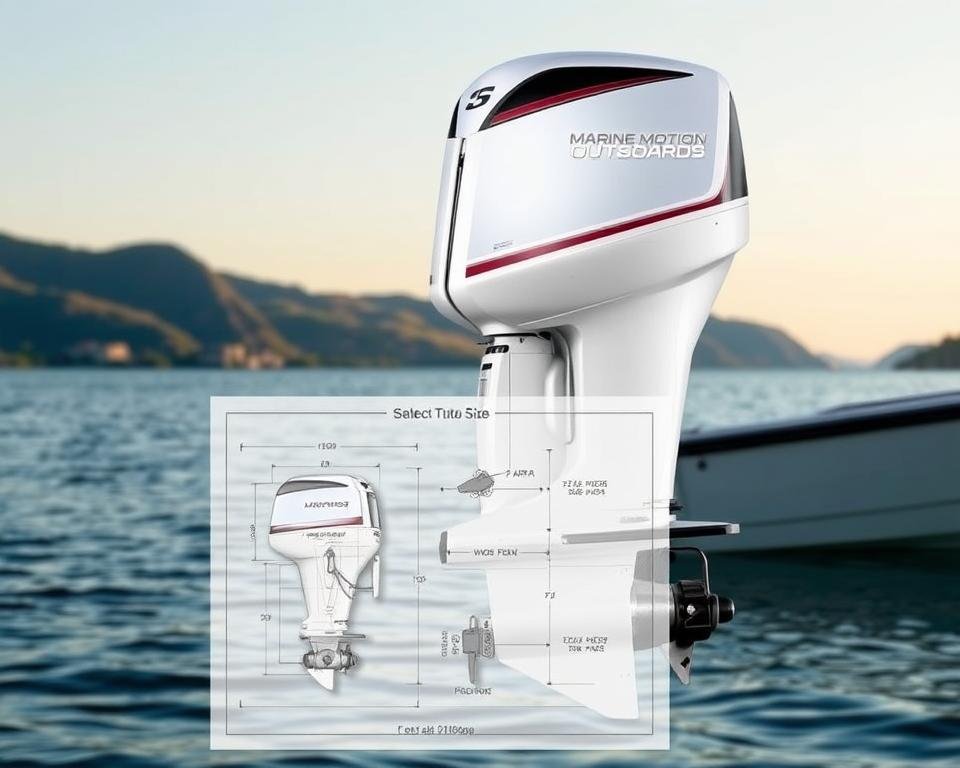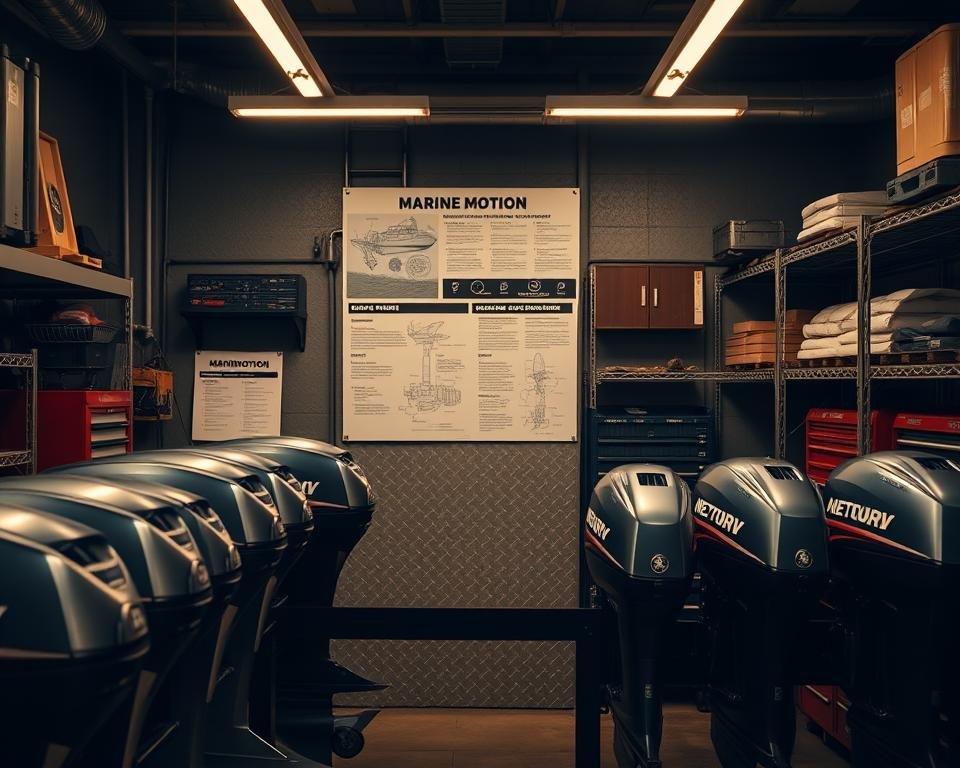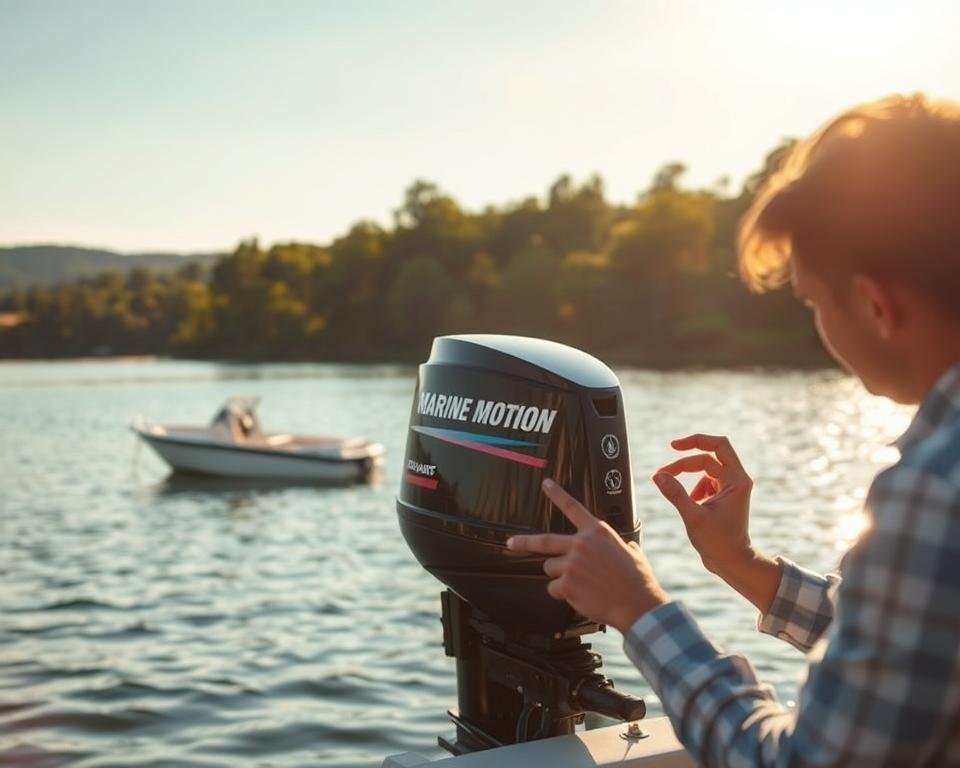Are you wondering if your boat has the right outboard motor size for the best performance and safety? Choosing the correct boat motor size is key for a fun and efficient boating trip.
Finding the perfect outboard motor can seem tough, but it’s very important. The right size motor makes your boat run smoothly, saves fuel, and keeps you safe on the water.
Knowing what affects choosing outboard motor size is important. In this article, we’ll look at the main things to consider. This will help you find the best motor size for your boat, making your boating trips even better.
Understanding the Importance of Proper Motor Sizing
Choosing the right outboard motor size is key for your boat’s efficiency and safety. The right size motor can greatly improve your boating experience. It affects how well your boat performs, how much fuel it uses, and how much fun you have on the water.
Performance Implications
The size of your outboard motor affects your boat’s speed, how fast it can go, and how easy it is to steer. A motor that’s too small might have trouble getting your boat moving. On the other hand, a motor that’s too big can be hard to handle and might wear out your boat’s back too quickly.
Safety Considerations
Choosing the right outboard motor is also about safety. A motor that’s not the right size can make your boat hard to control, which is risky, even in calm waters. The right size motor keeps your boat stable and easy to steer, lowering the chance of accidents.
Efficiency and Fuel Economy
Getting the motor size right is also good for saving fuel. A motor that matches your boat well uses less fuel, which saves money and is better for the environment. For example, the Suzuki DF90ATX outboard motor is known for being efficient and powerful.
| Motor Size | Performance Impact | Fuel Efficiency |
|---|---|---|
| Undersized | Poor acceleration, difficulty getting on plane | Potential for better fuel economy if load is managed |
| Oversized | Excessive speed, difficult to control | Poor fuel economy, increased operating costs |
| Correctly Sized | Optimal acceleration, smooth operation | Best fuel economy, balanced performance |
Key Factors That Determine Outboard Motor Size
The size of the outboard motor you need depends on your boat’s characteristics and how you plan to use it. Several key factors come into play when determining the appropriate outboard motor size.
Boat Length and Weight
The length and weight of your boat are key in choosing the right outboard motor size. A larger and heavier boat needs a more powerful motor for best performance. Manufacturers give guidelines on the recommended motor size based on the boat’s length and weight.
Hull Design and Type
The design and type of your boat’s hull also matter a lot. For example, a deep-V hull might need a different motor size than a flat-bottom hull. Knowing your boat’s hull characteristics is important for making a good choice.
Intended Use of Your Boat
How you plan to use your boat is also very important. Whether you’re fishing, cruising, or doing water sports, your boat’s use affects the motor size needed. For instance, a boat for water sports might need a more powerful motor than one for casual cruising.
Water Conditions You’ll Navigate
The water conditions you’ll be in also matter. For example, saltwater or rough seas might need a stronger motor than calm freshwater. This is because different conditions require different motor strengths.
What Size Outboard Motor Do I Need for My Boat? A Comprehensive Guide
The size of the outboard motor you need depends on several key factors. We’ll explore these in this guide. Choosing the right size is key for your boat’s performance, safety, and fuel use. We’ll cover the essential considerations for finding the perfect motor size for your vessel.
Basic Sizing Formulas
One way to find the right motor size is by using basic formulas. These formulas look at your boat’s length, width, and weight. A common rule is to use 25-40 horsepower for every 1,000 pounds of boat weight.
Manufacturer Recommendations
Another good approach is to follow your boat’s manufacturer guidelines. Most manufacturers give horsepower ranges for their boats. These ranges consider the boat’s design and use. You can find these in your owner’s manual or on the manufacturer’s website.
Capacity Plate Guidelines
The capacity plate on your boat is also helpful. It’s usually near the helm or on the transom. It shows the max weight, horsepower, and other important specs. Following these guidelines is key for safe and efficient boating.
By looking at these factors and guidelines, you can choose the right outboard motor size for your boat. Whether you want better performance, fuel efficiency, or safety, picking the correct motor size is vital. It ensures a great boating experience.
Understanding Horsepower Requirements
Knowing how much horsepower your boat needs is key. It helps your boat run well, stay safe, and use less fuel. The right amount of horsepower is all about finding that perfect balance.
Minimum vs. Maximum Horsepower
Boat makers give a range of horsepower ratings. The minimum horsepower is the least power needed to move the boat smoothly. The maximum horsepower is the most power the boat can handle without getting damaged.
The Weight-to-Horsepower Ratio
The weight of your boat and its horsepower are closely linked. A heavier boat needs more power to move like a lighter one. For example, the Suzuki DF90ATX, with 90 HP, is designed for boats within a specific weight range.
Calculating Optimal Power Needs
To figure out the best horsepower for your boat, think about its weight, how you plan to use it, and the water conditions. A common guideline is 1 HP for every 25-40 pounds of boat weight for normal conditions. But, this can change based on the boat’s design and how you use it.
| Boat Weight (lbs) | Recommended HP | Typical Use |
|---|---|---|
| 1,000-2,000 | 25-50 HP | Fishing, Cruising |
| 2,000-3,000 | 50-100 HP | Cruising, Water Sports |
| 3,000-4,000 | 100-150 HP | High-Performance Activities |
By understanding these factors and calculating your boat’s specific needs, you can select the right outboard motor that enhances your boating experience.
Matching Motor Size to Different Boat Types
It’s key to pick the right outboard motor size for your boat. This ensures your boat performs well and stays safe on the water. Different boats need different motors because they’re used for different activities and conditions.
Fishing Boats and Bass Boats
Fishing and bass boats need motors that are powerful but also easy to control. A good motor size balances speed and control. For these boats, motors between 100 to 250 horsepower are usually best, depending on the boat’s size and fishing needs.
Pontoon Boats
Pontoon boats are stable and roomy, so they need bigger motors. The size of the motor for these boats can be from 150 to 400 horsepower. This depends on the boat’s size, weight, and how it’s used.
Jon Boats and Small Craft
Jon boats and small craft use smaller motors because they’re light and small. These boats need motors with less horsepower, usually between 20 to 100 horsepower. This depends on the boat’s size and where it’s used.
Deck Boats and Bowriders
Deck boats and bowriders are for fun activities and need motors that are both powerful and efficient. The motor size for these boats can vary, from 150 to 300 horsepower. This depends on the boat’s size and how many people it can carry.
Inflatable Boats
Inflatable boats, like RIBs, need motors that are both compact and strong. The motor size for inflatables can vary, from small motors for small boats to bigger motors for larger RIBs.
| Boat Type | Typical Motor Size Range (HP) |
|---|---|
| Fishing Boats/Bass Boats | 100-250 |
| Pontoon Boats | 150-400 |
| Jon Boats/Small Craft | 20-100 |
| Deck Boats/Bowriders | 150-300 |
| Inflatable Boats/RIBs | Varies (often 20-250) |
Choosing the right outboard motor size is important. It depends on the boat’s design, use, and where it’s used. The right motor size ensures your boat performs well, stays safe, and is efficient.
The Impact of Load Capacity on Motor Size
Choosing the right outboard motor size for your boat is key. The load capacity of your boat affects its performance, efficiency, and safety on the water.

Passenger Weight Considerations
The weight of passengers is a big factor in your boat’s load capacity. When selecting a boat engine size, think about the average weight of your passengers. More passengers mean a bigger load, which can affect the boat’s stability and how it moves.
Gear and Equipment Weight
The weight of gear and equipment also adds to the load. This includes fishing gear, coolers, and other items you’ll carry. The total weight of these can greatly impact the boat motor size you need.
Distributing Weight Properly
It’s important to distribute weight evenly for your boat’s stability and performance. Uneven weight can cause poor handling and increase the risk of capsizing. Even weight distribution helps in determining the optimal outboard motor size for your boat.
Two-Stroke vs. Four-Stroke Outboard Considerations
Choosing the right outboard motor depends on knowing the difference between two-stroke and four-stroke engines. This knowledge is key to picking the best motor for your boating needs.
Power Differences
Two-stroke outboard motors are lighter and more compact because they pack more power for their size. But, four-stroke motors, like the Suzuki DF90ATX, give smoother power and are often seen as more reliable.
Weight Implications
The weight of two-stroke and four-stroke motors affects your boat’s performance. Four-stroke motors are heavier, which can change how your boat handles and balances.
Fuel Efficiency Comparison
Four-stroke outboard motors use less fuel than two-stroke ones. This can save you money, which is a big plus for those who boat often.
Environmental Factors
Four-stroke motors are better for the environment because they emit less pollution. They also make less noise, which helps reduce noise pollution.
| Feature | Two-Stroke | Four-Stroke |
|---|---|---|
| Power Delivery | Higher power-to-weight ratio | Smoother power delivery |
| Weight | Lighter | Heavier |
| Fuel Efficiency | Less efficient | More efficient |
| Environmental Impact | Higher emissions | Lower emissions |
Performance Goals and Motor Selection
To get the boating performance you want, picking the right outboard motor is key. Your goals for performance help decide which motor is best for your boat.
Cruising vs. High-Speed Performance
Choosing an outboard motor means thinking about what you want. Do you like to cruise at a steady pace or seek fast speeds? A motor for cruising offers stable and efficient speeds. For thrill-seekers, a high-performance motor is the way to go.
Fuel Economy Considerations
Fuel efficiency is important when picking a motor. A motor that uses less fuel can save you money over time. For example, the Suzuki DF90ATX is known for being fuel-efficient. It’s perfect for those who want to save on fuel without losing performance.
Handling Different Water Conditions
The water you boat in affects your motor choice. Whether it’s calm lakes or rough seas, your motor needs to handle it. A strong outboard motor keeps your boat stable and in control, making your boating better.
| Performance Goal | Motor Characteristics | Example Models |
|---|---|---|
| Cruising | Stable, Fuel-Efficient | Suzuki DF90ATX |
| High-Speed | High Power Output | Yamaha V8 XTO |
| Versatility | Adjustable Prop Pitch | Mercury Verado |
Legal and Regulatory Considerations
Choosing an outboard motor means looking at legal and regulatory rules. Boat owners need to know the laws that affect their motor choice.
Maximum Horsepower Restrictions
Boats have a capacity plate showing the max horsepower allowed. Going over this can risk your warranty and safety. For example, the Suzuki DF90ATX is built to stay within safe horsepower limits.
Emission Standards
Outboard motors must meet EPA and CARB emission standards. The Suzuki DF90ATX meets these, helping the environment. Following these standards is a legal must and helps protect our planet.
Local Waterway Regulations
Waterways have their own rules for outboard motors. These can cover motor type, noise, and permits. Boat owners must know these to avoid fines and follow the law.

Common Mistakes When Choosing Outboard Motor Size
Finding the right outboard motor size is key for safety, efficiency, and fun on the water. Many boat owners make big mistakes when picking their motor. These mistakes can cause poor performance and safety risks.
Overpowering Your Boat
Choosing a motor that’s too big can make your boat hard to control. It also increases the chance of damage. Always stick to the horsepower limits set by the manufacturer.
Underpowering Your Boat
Going for a motor that’s too small means your boat won’t perform well. It will be slow to start and hard to handle in tough waters. Make sure your boat has enough power for a great time on the water.
Ignoring Weight Distribution
Not thinking about weight distribution can mess up your boat’s balance and handling. Getting the weight right is important for both performance and safety.
Overlooking Long-Term Needs
Not considering your future plans can lead to a motor that doesn’t fit your boat later on. Think about your long-term goals when picking a motor size.
By avoiding these common mistakes, boat owners can make their boating experience better. It will be safer and more enjoyable.
Budget Considerations for Different Motor Sizes
When choosing an outboard motor, your budget is key. It’s not just about the upfront cost. You also need to think about ongoing expenses.
Initial Purchase Costs
The price of an outboard motor changes with its size and features. Bigger motors with more features cost more.
Long-term Operating Expenses
Over time, you’ll spend money on fuel, maintenance, and repairs. Four-stroke motors use less fuel than two-stroke ones.
| Motor Size | Initial Cost | Annual Operating Cost |
|---|---|---|
| Small (2-5 HP) | $500-$2,000 | $200-$500 |
| Medium (5-20 HP) | $2,000-$6,000 | $500-$1,500 |
| Large (20-100 HP) | $6,000-$20,000 | $1,500-$3,000 |
Resale Value Implications
Bigger, high-quality motors hold their value longer than smaller ones.
Financing Options
There are financing options for outboard motors, like the Suzuki DF90ATX. This makes it easier to find the right motor for you.
Conclusion
Choosing the right outboard motor size is key for your boat’s performance and safety. This article has covered important factors like boat size, weight, and use. These all affect the best motor size for your needs.
When picking a motor, think about the manufacturer’s advice and sizing formulas. The right size motor means better performance and safety on the water.
Choosing the right motor size involves looking at horsepower, load capacity, and performance goals. Knowing these helps you make a smart choice.
The perfect motor size balances performance, efficiency, and cost. By following the tips in this article, you can pick the best motor for your boat. This ensures a safe and fun time on the water.


